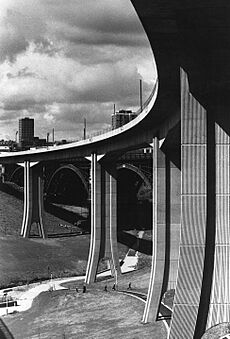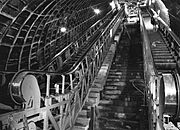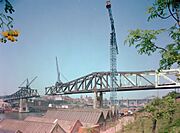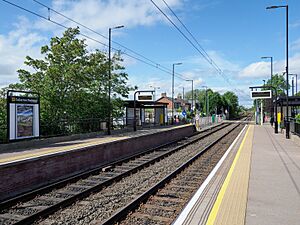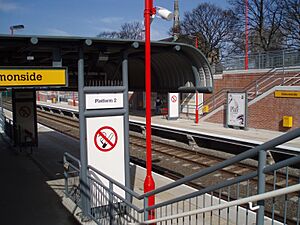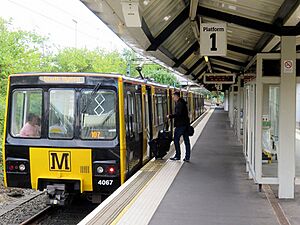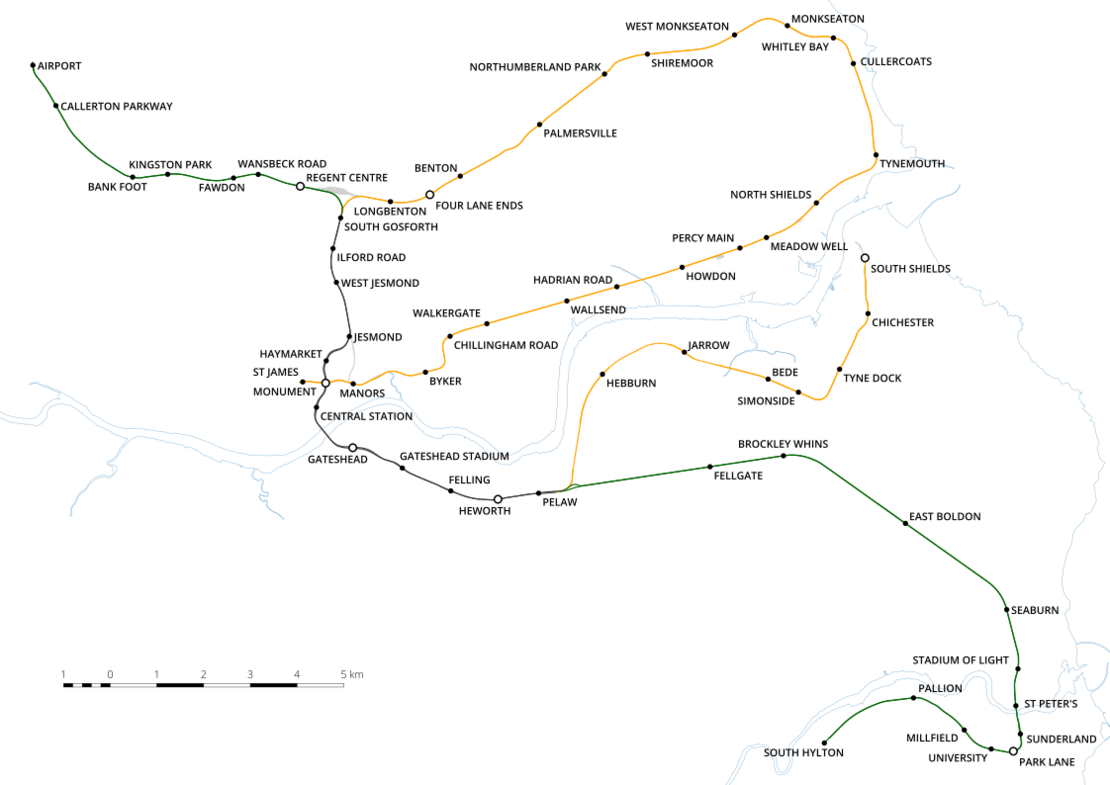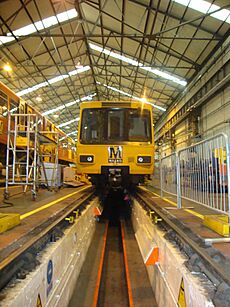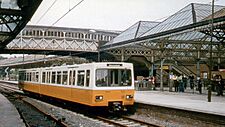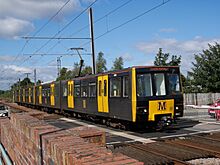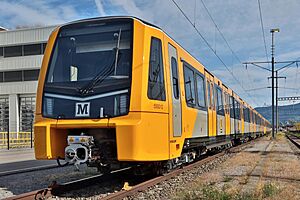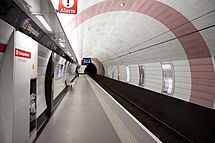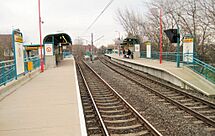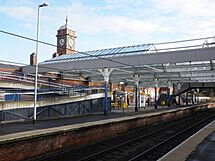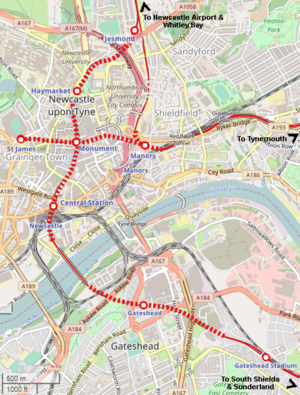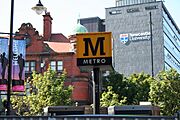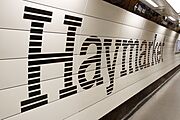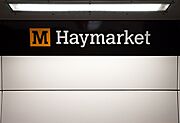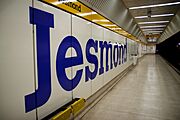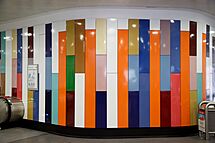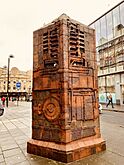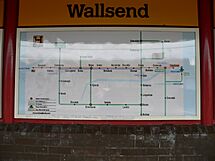Tyne and Wear Metro facts for kids
Quick facts for kids Tyne and Wear Metro |
|
|---|---|
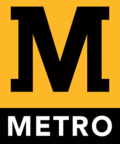 Tyne_and_Wear_Metrocar_4053.jpg |
|
| Info | |
| Owner | Tyne and Wear Passenger Transport Executive (Nexus) |
| Locale | Tyne and Wear |
| Transit type | |
| Number of lines | 2 |
| Number of stations | 60 |
| Headquarters |
|
| Operation | |
| Began operation | 11 August 1980 |
| Operator(s) | Tyne and Wear Passenger Transport Executive (Nexus) |
| Number of vehicles |
|
| Train length | 27.81 m (91 ft 3 in) |
| Technical | |
| System length | 77.5 km (48.2 mi) |
| Track gauge | 4 ft 8 1⁄2 in (1,435 mm) standard gauge |
| Electrification | 1,500 V DC |
| Top speed | 80 km/h (50 mph) |
The Tyne and Wear Metro is a special train system that runs both above and below ground. It helps people travel around Newcastle upon Tyne, Gateshead, North Tyneside, South Tyneside, and the City of Sunderland. These areas together make up Tyne and Wear. The company that owns the Metro, Nexus, calls it "Britain’s first light rapid transit system." This means it's a fast, modern train system.
The idea for the Metro started in the early 1970s. It used many parts of an older train network called the Tyneside Electrics, which had some sections built as far back as 1834. Building the Metro began in 1974. Workers built new tunnels and bridges, connecting them to old railway lines that were changed for the Metro. New trains, called Metrocars, were also bought.
The first part of the Metro opened in August 1980. The original network was finished in March 1984. At first, Metro trains and local buses worked together, but this changed in the late 1980s.
The Metro system grew with new sections. An extension to Newcastle Airport opened in November 1991. Another extension to Sunderland and South Hylton was finished in March 2002. By 2013, the Metro had 60 stations, both underground and above ground, covering about 77.5 kilometers (48 miles) of track. Nexus usually runs the Metro directly. However, from 2010 to 2017, another company called DB Regio operated it. After that contract ended, Nexus took over again.
In 2016, Nexus started a plan to replace its older trains, which were from the 1980s. A project called Metro Flow, announced in March 2020, is spending £103 million to make trains run more often. It will also make journeys faster and more reliable. The first new train, a Class 555, started carrying passengers on December 18, 2024.
Contents
History of the Metro
How the Metro Started
The Metro uses many parts of old railway lines. Some of these were built between 1834 and 1882. One of the oldest parts is the Newcastle & North Shields Railway, which opened in 1839. In 1904, the North Eastern Railway started using electricity for some of its local train lines north of the River Tyne. This was to compete with new tramways. These electric lines were called the Tyneside Electrics. In 1938, the line south of the River Tyne to South Shields also became electric.
In the 1960s, the old electric trains were replaced with diesel trains. This happened because fewer people were using the trains, and it was expensive to fix the old electric system. Many people thought this was a bad idea because the diesel trains were slower.
Planning and Building the Metro
In the early 1970s, people realized that the poor local transport system was holding back the region's economy. So, in 1971, a study was done to find ways to make transport better.
The study suggested bringing back the old Tyneside Electrics network. The idea was to turn it into a modern electric train system. This new system would include new underground sections in the busy city centers of Newcastle and Gateshead. The old train lines didn't serve these areas well enough. The plan was for the Metro to be the main part of a new transport system, with buses bringing passengers to and from Metro stations. The government helped pay for about 70% of the project.
Three railway lines, about 42 kilometers (26 miles) long, were changed into Metro lines. These included the North Tyneside Loop and the line from Newcastle to South Shields. A short freight line was also converted.
About 10 kilometers (6 miles) of new tracks were built to connect the old lines and create the new underground routes. About 6.4 kilometers (4 miles) of these new tracks were in tunnels. The rest were above ground or on raised structures. Important raised sections included the Queen Elizabeth II Bridge, which carries the Metro over the River Tyne, and the Byker Viaduct, a long bridge across the Ouseburn Valley.
Building work started in October 1974. This included building new tracks, adding electric power lines, updating or moving old stations, and building new ones, some underground. The project cost £265 million by 1984. The Tyne and Wear Metro was the first railway in the UK to use the metric system for all its measurements. It was also designed to be fully accessible for people with disabilities, with easy access at all stations.
- Building the Metro
-
The escalator shaft at Haymarket being built in the late 1970s.
-
The Queen Elizabeth II Bridge over the River Tyne, almost finished in 1978.
Metro Opening Dates
The Metro opened in stages between 1980 and 1984. The first parts opened in August 1980. The last part of the original network opened in March 1984. Later, extensions to Newcastle Airport and Sunderland opened in 1991 and 2002.
Here are some of the opening dates for stations:
| Date | Station(s) |
|---|---|
| 11 August 1980 | Haymarket, Jesmond, West Jesmond, Ilford Road, South Gosforth, Longbenton, Four Lane Ends, Benton, Shiremoor, West Monkseaton, Monkseaton, Whitley Bay, Cullercoats, Tynemouth |
| 10 May 1981 | Regent Centre, Wansbeck Road, Fawdon, Bank Foot |
| 15 November 1981 | Heworth, Felling, Gateshead Stadium, Gateshead, Central Station, Monument |
| 14 November 1982 | North Shields, Meadow Well, Percy Main, Howdon, Hadrian Road, Wallsend, Walkergate, Chillingham Road, Byker, Manors, St James |
| 24 March 1984 | Hebburn, Jarrow, Bede, Tyne Dock, Chichester, South Shields |
| 15 September 1985 | Kingston Park |
| 16 September 1985 | Pelaw |
| 19 March 1986 | Palmersville |
| 17 November 1991 | Callerton Parkway, Newcastle Airport |
| 31 March 2002 | Fellgate, Brockley Whins, East Boldon, Seaburn, Stadium of Light, St Peter's, Sunderland, University, Millfield, Pallion, South Hylton |
| 28 April 2002 | Park Lane |
| 11 December 2005 | Northumberland Park |
| 17 March 2008 | Simonside |
The part of the Metro that goes to Sunderland shares tracks with other trains. This section is looked after by the British Transport Police. The rest of the Metro network is looked after by Northumbria Police.
How Metro and Buses Worked Together
When the Metro first opened, it was meant to be part of a big transport system. Local buses were planned to bring people to Metro stations. The Metro would handle longer journeys, and buses would do shorter, local trips. You could even buy one ticket for both. Special transport hubs were built for this, like Heworth. However, this idea didn't last long. It ended in 1986 when bus services became less regulated. You can still buy special tickets that let you use different types of transport in Tyne and Wear.
Metro Growth and Changes
Extension to Newcastle Airport
In November 1991, the Metro line was extended to Newcastle Airport. This cost £12 million. The new section was about 3.5 kilometers (2.2 miles) long. It followed an old railway line and added two new stations: Callerton Parkway and Airport.
Extension to Sunderland
In March 2002, a £100 million extension opened, covering about 18.5 kilometers (11.5 miles). This line went from Pelaw to Sunderland and South Hylton. It used part of an existing railway line, allowing both Metro and regular trains to use the same tracks. This was a new idea for the UK. Several stations were rebuilt or newly built along this route.
Future Plans for Washington
There have been many ideas to extend the Metro to Washington. In 2020, new plans were suggested to connect the Metro from Pelaw and South Hylton to Washington. This would use parts of an old railway line.
In November 2022, the first steps for this project were announced. The plan is to get funding from the government, as it's expected to cost £745 million. In July 2024, the Mayor of the North East provided £8.6 million to help develop the plan further. The idea is to create a loop by connecting South Hylton to Pelaw, with new stations at Washington South, Washington North, and Follingsby. In June 2025, it was announced that £900 million of new government funding would be used to build this extension. The goal is for it to open by 2033.
Metro Upgrades
Metro: All Change Programme
The Metro has gone through a big upgrade programme called Metro: All Change.
Phase 1: New Ticket Machines and Station Upgrades
The first part of All Change involved a £25 million project to install new ticket machines at all 60 stations. These new machines can take credit and debit cards, notes, and coins. They also added automatic ticket barriers at 13 busy stations and smart card readers everywhere.
This phase also saw a new station open at Simonside in March 2008. Haymarket station was also updated in 2009. Other stations were refurbished, and lifts and escalators were replaced. The tracks and power lines were also improved.
Phase 2: Train Makeover and Station Rebuilding
Phase 2 included a £20 million project to refurbish 86 of the old Metrocars. Each train was taken apart and rebuilt. They got better access for disabled passengers, new door systems, and updated interiors with new seats and lighting. They also got a new black and yellow paint job. This work started in June 2010 and finished early in August 2015.
This phase also updated 45 more stations, including rebuilding North Shields station, which finished in September 2012. New communication systems were installed, and bridges, tunnels, and tracks were maintained.
Phase 3: Brand New Trains
The third phase of Metro: All Change started in 2019. This involved buying a whole new fleet of 46 trains from a Swiss company called Stadler. The first new train arrived in February 2023. It started carrying passengers on December 18, 2024. The rest of the new trains will be slowly introduced over 2025 and 2026. As each new train arrives, an old one will be removed. All the old trains are expected to be replaced by 2026.
Maintenance and Training Centre
In July 2018, Nexus announced a new training center in South Shields. This £8.4 million project opened in November 2020. It has classrooms, a pretend control room, a driver training simulator, and even a mock Metro station. There's also a 70-meter (230 ft) section of track for training on tracks, signals, and power lines. This place is also used to store and fix some trains.
Metro Flow Project
In March 2020, the government announced a £103 million project called Metro Flow. This project aims to make trains run more often, from five to six trains per hour. It will also make journeys faster and more reliable. Starting in September 2022, three sections of single track between Pelaw and Bede are being changed to dual tracks. An old freight line is also being electrified and adapted to be shared with the Metro, similar to the line to Sunderland. This project also funded four extra new Stadler trains.
The Metro Network
The Tyne and Wear Metro network is a mix of different train types. It has parts that feel like a light rail, parts like a heavy underground metro, and parts like a longer-distance suburban railway. Nexus calls it "light rapid transit," but the government calls it a "light rail" system.
Metro Services
The Metro network has two main lines. As of December 2024, trains usually run like this during quieter times:
| Green line | ||
|---|---|---|
| Route | tph | Calling at |
| South Hylton to Airport | 5 |
|
| Yellow line | ||
| Route | tph | Calling at |
| South Shields to St James via Whitley Bay | 5 |
|
Trains usually start running between 5:00 AM and 6:00 AM (a bit later on Sundays). They run frequently until about midnight. During the day, trains on each line come every 12 minutes. In the evenings and on Sundays, they come every 15 minutes. This means that between Pelaw and South Gosforth, you can get a train every six minutes during the day. More trains run during busy morning and evening times, making the wait even shorter.
Metro Map
Metro Trains and How They Operate
Control Centre
The Metro Control Centre is in Gosforth. This is where people manage the network's signals and electricity. They also talk to train drivers and other staff using radios. The control center got new computer systems in August 2018, costing £12 million.
Train Depots
The Metro trains are kept and maintained at a main depot in Gosforth. This depot opened in 1923 for the old Tyneside Electrics trains. The Metro took it over when it opened in 1980. It's used for storing, cleaning, and fixing the trains.
A new temporary depot was built near Howdon in North Tyneside. It opened in August 2020 and can hold up to 10 Metrocars. This is while the main depot in Gosforth is being updated. Another place for storing and maintaining trains is also planned to open in South Tyneside.
Original Metro Trains
Since the Metro opened in 1980, it has used the same type of trains, called Metrocars. There are 87 of these trains, numbered 4001 to 4090. They usually run in pairs and can go up to 80 kilometers per hour (50 mph). The first two prototype trains were delivered for testing in 1975. The other 88 trains were built between 1978 and 1981. The design of the Metrocar was based on a German light rail train. They were built by Metro-Cammell.
The trains have been updated several times and have had different paint jobs. Originally, they were yellow and white. Later, they were painted red, green, or blue with yellow fronts. A big £20 million refurbishment of 86 Metrocars started in June 2010. The goal was to make them last until 2025, before the new trains arrived. Each train was completely rebuilt with better access for disabled passengers, new doors, and updated interiors. They also got a new black, grey, and yellow paint scheme. This work finished in August 2015.
New Metro Trains
In 2016, Nexus planned to get £550 million for a new fleet of trains. In November 2017, the government said it would give £337 million towards these new trains.
In January 2020, Stadler won the contract to build and maintain 42 new five-carriage trains. Deliveries started in early 2023. The first new train began passenger service on December 18, 2024. The rest of the trains will be slowly introduced over 2025 and 2026. The new trains have screens showing the next stop, more space for passengers, wider doors, air conditioning, WiFi, and charging points. Because of the Metro Flow project, four more trains were funded, bringing the total to 46.
By August 2024, three of the first nine new trains had finished their daytime testing. The focus then moved to training drivers. The new trains will completely replace the old fleet by 2026.
Other Metro Vehicles
Besides passenger trains, the Metro also has three battery-electric locomotives. These were built in 1988 and are used for maintenance work. The company also has a special machine for leveling the tracks and 15 wagons used for repairs.
Metro Ownership
The Tyne and Wear Metro is owned by the public. It gets money from local taxes and the government. Nexus owns and manages the Metro. For a while, from 2010 to 2017, Nexus hired another company, DB Regio, to operate the trains and handle maintenance. This was part of a deal to get money for upgrades. Nexus still decided on ticket prices, how often trains ran, and operating hours.
In March 2016, Nexus announced they would not renew the contract with DB Regio. They were not happy with DB Regio's performance. In April 2017, Nexus took over running the system directly again. The RMT trade union believes that Nexus should continue to operate the Metro directly and keep it publicly owned. As of March 2021, the Metro is still publicly owned and operated by Nexus.
Metro Infrastructure
Stations
The Metro has 60 stations, and they all look different. Some were old railway stations, while others were built just for the Metro. Most stations are above ground. However, several in central Newcastle and Gateshead are underground, like Central, Monument, and Gateshead. In Sunderland, Park Lane and Sunderland stations also have underground platforms.
Most Metro stations don't have staff all the time. But the busiest stations in Newcastle and Sunderland are staffed until late in the evening. All stations have ticket machines, shelters, seating, screens showing when the next train will arrive, and emergency help points. The ticket machines accept cards, notes, and coins. Some stations also have automatic ticket barriers. Even though most stations are open, the Metro earns a lot of money from tickets. Inspectors regularly check tickets on trains and at stations. If you travel without a ticket, you might have to pay a £100 fine.
In June 2022, it was announced that special bumpy paving, called tactile paving, was installed at all Metro stations. This helps people with visual impairments.
- Metro Stations
-
Haymarket, one of the first underground stations to be updated.
Bicycles on the Metro
Most Metro stations have bike racks. Some stations also have smart bike lockers. You can take non-folding bikes on the Metro during certain times: weekdays between 10:00 AM and 3:00 PM, and after 7:00 PM. You can also take them all day on weekends. However, there are some parts of the network where non-folding bikes are never allowed. Folding bikes are allowed anywhere on the Metro, as long as they are folded up and don't get in the way of other passengers.
Metro Tunnels
Under Newcastle, two Metro lines run underground and cross each other at Monument. This station has four platforms on two levels. One line runs north to south, going underground at Jesmond and passing through Haymarket, Monument, and Central. It then goes above ground to cross the Queen Elizabeth II Bridge over the River Tyne. After that, it enters another tunnel under Gateshead, serving Gateshead, before coming above ground again.
The second underground line runs east to west. It goes underground after running alongside the East Coast Main Line, serving Manors and Monument, and ending at St. James. Trains on the Yellow Line go through Monument twice, on different platforms.
The Metro tunnels were built in the late 1970s using mining methods. They are single-track tubes. The tunnels under Newcastle were dug through clay and lined with iron or concrete. The tunnel under Gateshead was dug through sandstone and old coal mines. Old mine workings, some from the Middle Ages, had to be filled in before digging began.
Level Crossings
There are seven places where the Metro tracks cross roads at the same level. Five of these crossings are managed by Nexus and don't have barriers because the trains come so often. Three others are near East Boldon and are shared with other railway lines. These have barriers because freight trains and other national trains use them.
Distances on the Metro
Distances on the Metro system are measured from a starting point at South Gosforth. The system uses the metric system, so distances are in kilometers, rounded to the nearest meter. Lines are called In and Out. The In line goes from St. James to South Shields by going inside the North Tyneside Loop. The Out line goes the other way.
You can see distance plates on the structures that hold up the overhead power lines. The part of the line between Pelaw and South Hylton is owned by Network Rail. This section has distances marked in both metric units (kilometers) and old British units (miles and chains).
Electrification
The Tyne and Wear Metro uses overhead lines to power its trains with 1,500 volts of direct current (DC). It's the only railway network in the UK that uses this specific system. Nexus hopes to change the power system on the shared line between Pelaw and Sunderland to the standard used by Network Rail (25,000 volts AC). If they do this, they would need new trains that can use both power systems.
Signalling
The Metro has a system called Indusi that helps keep trains safe. It can stop trains if they go past a red signal. This is different from the systems used on most other British railways. Drivers control the trains. A special system controls signals at stations and track switches. The rest of the network uses standard signals. Trains can run as close as three minutes apart.
Metro Ridership
In the 1985–86 financial year, the Metro carried 59.1 million passengers, which is the most it has ever carried. By 1987–88, this number dropped to 44.9 million. This drop happened because the Metro and bus services stopped working together closely after 1986. Passenger numbers continued to fall in the 1990s, reaching a low of 32.5 million in 2000–01. After that, passenger numbers went up and stayed steady, usually between 35 and 40 million passengers each year. Before 2016–17, the Metro was the second most used tram and light rail network in the UK, after London's Docklands Light Railway. Ridership dropped a lot during the COVID-19 pandemic, reaching a very low point of 9.4 million in 2020–21. Now, the Metro is the third most used tram and light rail network in the UK, after the Docklands Light Railway and the Manchester Metrolink.
| Year | Passenger journeys |
Year | Passenger journeys |
Year | Passenger journeys |
Year | Passenger journeys |
Year | Passenger journeys |
Year | Passenger journeys |
|||||
|---|---|---|---|---|---|---|---|---|---|---|---|---|---|---|---|---|
| 1983/84 | 49.8M | 1991/92 | 40.6M | 1999/00 | 32.7M | 2007/08 | 39.8M | 2015/16 | 40.3M | 2023/24 | 30.7M | |||||
| 1984/85 | 57.2M | 1992/93 | 38.9M | 2000/01 | 32.5M | 2008/09 | 40.6M | 2016/17 | 37.7M | 2024/25 | ||||||
| 1985/86 | 59.1M | 1993/94 | 38.3M | 2001/02 | 33.4M | 2008/09 | 40.8M | 2017/18 | 36.4M | 2025/26 | ||||||
| 1986/87 | 46.4M | 1994/95 | 37.0M | 2002/03 | 36.6M | 2009/10 | 40.8M | 2018/19 | 36.4M | 2026/27 | ||||||
| 1987/88 | 44.9M | 1995/96 | 35.9M | 2003/04 | 37.9M | 2010/11 | 39.9M | 2019/20 | 33.1M | 2027/28 | ||||||
| 1988/89 | 45.4M | 1996/97 | 35.4M | 2004/05 | 36.8M | 2011/12 | 37.9M | 2020/21 | 9.4M | 2027/28 | ||||||
| 1989/90 | 45.5M | 1997/98 | 35.0M | 2005/06 | 35.8M | 2012/13 | 37.0M | 2021/22 | 24.3M | 2028/29 | ||||||
| 1990/91 | 43.6M | 1998/99 | 33.8M | 2006/07 | 37.9M | 2014/15 | 38.1M | 2021/22 | 24.3M | 2022/23 | 29.3M | 2029/30 | ||||
| Estimates from the Department for Transport | ||||||||||||||||
Metro Look and Feel
The Tyne and Wear Metro has a special look and feel. This was created to make it stand out from the old train system it replaced. It also matched the look of the buses at the time. The Calvert typeface (a type of font) was first used on the Metro. It's used everywhere, including on the black 'M' logo on a yellow background. This logo helps people recognize the Metro.
In 2009, as part of the Metro: All Change programme, the Metro's look was updated. The new design focused on the Calvert typeface for signs and maps. It also introduced a simpler color scheme of black, white, grey, and yellow for updated stations, signs, and trains. Haymarket was the first station to be updated with this new look in 2009.
- Metro Branding and Signs
Art on the Metro
There are over 30 pieces of permanent art across the transport network in Tyne and Wear. Many Metro stations have special artworks created by different artists. Some examples include:
- Haymarket: Canon (2010) by Lothar Goetz
- Jarrow: Jarrow March (1984) by Vince Rea
- Monkseaton: Beach and Shipyards (1983) by Mike Davies
- Monument: Parson's Polygon (1985) by David Hamilton
- Queen Elizabeth II Bridge: Nocturne (2007) by Nayan Kulkarni
- Sunderland: Platform 5 (2011) by Jason Bruges Studio
- Wallsend: Pontis (2003) by Michael Pinsky
See also
 In Spanish: Metro de Tyne y Wear para niños
In Spanish: Metro de Tyne y Wear para niños
- List of Tyne and Wear Metro stations
- Transport in Tyne and Wear
- Urban rail in the United Kingdom



